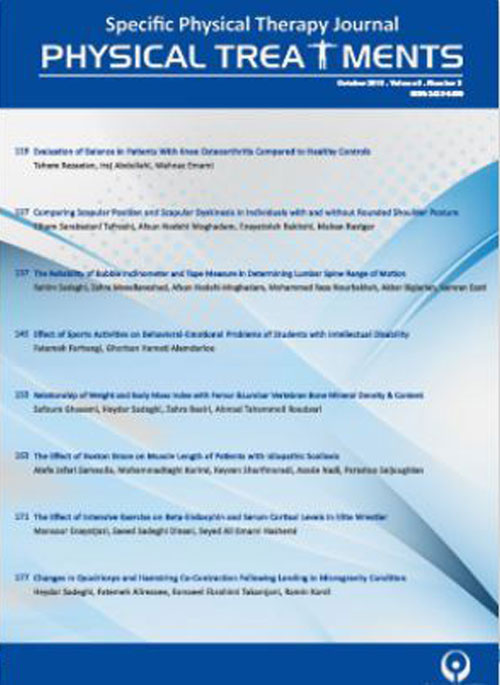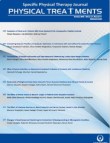فهرست مطالب

Physical Treatments Journal
Volume:12 Issue: 2, Spring 2022
- تاریخ انتشار: 1401/05/31
- تعداد عناوین: 7
-
-
Pages 65-75Purpose
Due to the paucity of information regarding the lower limb biomechanics in running at slow speed, as well as the concentration of most previous studies on a single movement plane, this study aimed to investigate lower limb joint kinetics with increasing running speed.
MethodsTwenty-eight runners were asked to stay on the treadmill at a bent velocity which was incrementally increased to 2.5 m/s, 3.5 m/s, and 4.5 m/s speeds. The three-dimensional joint moment and sagittal mechanical muscle power of the lower limb were calculated during the stance phase of running. Repeated measures analysis of variance (ANOVA) with Bonferroni post hoc test was used to examine the variables during running at various speeds.
ResultsThe results showed that at the hip joint in the frontal plane, an adduction moment developed in the middle of the stance phase, and the highest peak adduction moment was obvious at the highest speed condition (4.5 m/s). Also, the time elapsed to peak in the highest speed condition was less than the others. In the transverse plane, although the 3.5 m/s-speed condition experienced the maximum external rotation peak moment, the 4.5 m/s-condition speed reached the internal status earlier than the two other speeds. In the sagittal plane, the highest speed condition showed the highest extension and flexion moments.
ConclusionIncreasing running speed in runners leads to more kinetic output and mechanical power gradient.
Keywords: Kinetics, Running, Lower limb, Biomechanics -
Pages 77-84Purpose
Sub-acromial impingement syndrome (SAIS) is one of the most common causes of shoulder pain and affects shoulder joint proprioception. The closed kinetic chain (CKC) exercises with sling are more effective and safer than open kinetic chain (OKC) exercises. This study aimed to compare the effectiveness of OKC and total-body resistance exercises (TRX) sling training on shoulder joint position sense (JPS) in overhead athletes with shoulder impingement syndrome (SIS).
MethodsThis article was a randomized control trial (RCT) study conducted in Kerman City, Iran, in 2019. The research sample included 33 overhead athletes with SIS who were randomly classified into three groups: OKC, sling, and control groups. Joint position sense (JPS) was evaluated in external rotation (ER), internal rotation (IR), and abduction of the dominant arm in the target angle concerning the shoulder range of motion with the Leighton flexometer. The obtained data were analyzed using the analysis of covariance (ANCOVA).
ResultsThe post-intervention results showed that a significant difference was observed between groups (ER, P<0.001; IR, P<0.001; abduction P<0.001). The change in the sling exercises group was significantly higher in ER, and IR, except abduction JPS than in OKC (P=0.001, P=0.001, P=0.235, respectively) and control groups (P<0.001, P<0.001, P<0.001, respectively). Change in the OKC group was significantly higher in ER, IR, and abduction JPS (P=0.001, P=0.019, P<0.001, respectively) than in the control group. The OKC and sling exercise improved the shoulder JPS of overhead athletes with SIS.
ConclusionThe study results showed that the sling exercises were more effective than the OKC exercise for the shoulder JPS because these exercises were CKC and performed on an unstable level.
Keywords: Exercise therapy, Proprioception, Athletes, Shoulder Impingement Syndrome -
Pages 85-92Purpose
Various complications, including physical, cognitive, and functional disorders, have been identified in patients discharged and recovered from COVID-19. Pulmonary rehabilitation (PR) can be considered a strategy for these disorders. This study aimed to investigate the effect of respiratory and core stability tele-exercises on pulmonary function and functional capacity in survivors discharged and recovered from COVID-19.
MethodsThis randomized clinical trial study was performed in Qom Province, Iran, in 2021. Thirty discharged patients voluntarily participated in this study and were randomly divided into two groups of 15 patients. Eventually, 27 patients in two groups of exercise (13 patients) and control (14 patients) completed this study. The exercise group performed respiratory and core stability tele-exercise for 8 weeks. Before and after the exercise program, pulmonary function, including forced vital capacity (FVC), forced expiratory volume in 1 s (FEV1), FEV1/FVC ratio, and six-minute walk test (6MWT) were assessed in both groups. Mixed repeated measures test in SPSS software v. 27, was used to compare the mean of pre-test-post-test information of the groups. The significance level for this study was considered 0.05.
ResultsIn the exercise group, a significant improvement was observed in FVC, FEV1, and 6MWT after the intervention (P≤0.05), but no significant difference was observed in the FEV1/FVC ratio (P>0.05). Furthermore, a significant interaction was observed in 6MWD, FVC, FVC (predicted), FEV1, and FEV1 (predicted). However, in FEV1/FVC ratio, no significant interaction was observed between the two groups (P>0.05).
ConclusionThe results of the study showed that in the new crisis resulting from persistent complications of COVID-19, respiratory and core stability exercises by the tele-exercise method could be used as a helpful method in the rehabilitation of patients discharged and recovered from COVID-19 disease.
Keywords: COVID-19, Survivors, Core stability, Respiratory function tests, Telerehabilitation -
Pages 93-102Purpose
Most studies have examined the effect of stretching and strengthening exercises on the glenohumeral joint (shoulder joint). However, due to the importance of the relationship between core stability and pectoral girdle, especially in archery athletes, this study aimed to investigate the effect of six weeks of core stability exercises on the internal rotator muscle strength of the glenohumeral joint and its motor function in male archers.
MethodsFor this purpose, 30 athletes were randomly divided into 2 groups of 15: with core stability exercises (experimental group) and without core stability exercises (control group). The motor function was measured using the upper quarter Y-balance test (UQYBT), and the muscle strength of the lumbar muscles was measured using a hand-held dynamometer (HHD). Then, the experimental group underwent a selected exercise program for 6 weeks. Both groups were tested again (post-test). SPSS software version 21 was used to analyze the collected data; also, independent and dependent samples t-tests were used to compare the data. The significance level in the test was determined at 95%.
ResultsChanges in posttest results on internal rotator muscle strength (P=0.001) and motor function (P=0.022) showed a significant difference between the two groups.
ConclusionTherefore, due to the effect of core stability exercises on the above variables, it is recommended that archery athletes, in addition to specific exercises, do such exercises to improve the function of the glenohumeral joint.
Keywords: Core stability exercises, Glenohumeral joint, Archer -
Pages 103-112Purpose
Osteoarthritis is a degenerative joint disease affecting synovial joints and damages joints due to stresses caused by an abnormality in any of the synovial joint tissues, including articular cartilage and subchondral bone, ligaments, menisci, periarticular muscles, peripheral nerves, and synovium. To compare the effect of sensory-motor training versus impairment-based training on pain and physical function in subjects with knee osteoarthritis.
MethodsSimple random sampling was used to divide 30 subjects aged 50 and 70 years who met the inclusion and exclusion criteria into two groups (n=15). Group A received sensory-motor training, while Group B received impairment-based training. Before the treatment, the subjects walked for 10 minutes to warm up. For three weeks, each group was treated three times per week. Pre-test; post-test outcomes are noted, the visual analog scale (VAS) was used to assess pain, and the Western Ontario and McMaster Universities osteoarthritis index (WOMAC) was used to assess physical function.
ResultsComparing the post-test pain (VAS) scores between groups showed that the mean±SD of posttest pain (VAS) score in the sensory-motor training group was 2.707±1.01. The mean±SD in the impairment-based training group was almost the same, at 2.29±1.13. It was statistically significant at the 5% level. Similarly, the mean±SD of the posttest function (WOMAC) score in the sensory-motor training group was 16.55±6.92.
ConclusionSensory-motor training is superior to impairment-based training on pain and physical function in subjects with knee osteoarthritis.
Keywords: Knee osteoarthritis, Sensory-motor training, Impairment-based training -
Pages 113-122Purpose
Despite the widespread use of cryotherapy in sports, there is no specific evidence of its impact on muscle activation, especially following fatigue-induced exercises. This study aimed to assess the impact of cryotherapy alone and after plyometric exercises on knee muscle activation during the drop jump task.
MethodsA total of 35 active female subjects (mean±SD age of 22.74±2.10 years, mean body mass index [BMI] of 20.02±2.55 kg/m2) participated in this quasi-experimental study with a pretest-Post-test design. There were three experimental groups (20-minute cryotherapy, plyometric, and plyometric-cryotherapy) and a control group. Electromyography (EMG) amplitudes of knee muscle activation (rectus femoris [RF], biceps femoris [BF], tibialis anterior [TA], medial gastrocnemius [MG]) were measured and compared in three phases of the drop-jump task (one feedforward preactivation and two feedback eccentric and concentric phases). Skin temperature was recorded before and after cooling intervention as well. For comparisons, repeated measure analysis of variance (ANOVA) was used at a significant level of 0.05.
ResultsThe results showed that the skin temperature decreased significantly after cryotherapy and was maintained for 20 minutes. No significant changes were observed in the EMG of knee muscles in the feedforward and concentric phase of the drop jump task in any groups (P>0.05). However, RF activation decreased following cryotherapy immediately and after 20 minutes as an eccentric phase (P=0.01) and had a significant difference from the control group (P=0.01); besides, EMG activation decreased in cryotherapy, plyometric, and plyometric-cryotherapy groups immediately (P=0.01). However, no significant differences were seen between them and the control group (P>0.05).
ConclusionAccording to the present results, cryotherapy alone and after fatigue-induced plyometric training had a minor effect on the knee muscle activation during a functional jumping movement, but the impact of these changes on knee biomechanics is insignificant; hence, further studies are essential for a better conclusion.
Keywords: EMG activation, Feedforward, Plyometric, Cryotherapy, Rectus femoris -
Pages 123-132Purpose
A proper warm-up method can be used as a strategy to improve the performance of athletes in various sports fields. The present study aimed to compare the effect of two traditional and post-activation potentiation (PAP) warm-up methods on electromyographic variables of lower limb muscles during squat jumps.
MethodsFourteen trained male athletes randomly performed three different protocols: traditional warm-up method, dynamic post-activation potentiation (PD) by implementing two dynamic half-squat repetitions with 90% 1RM (one rep maximum), and static post-activation potentiation (PS) warm-up by implementing two static half-squat repetitions with 90% 1RM. Vertical jump tests were performed five minutes after implementing each protocol (recovery time). EMG activity of the rectus femoris, vastus lateralis, vastus medialis, biceps femoris, semi-tendinous, medial gastrocnemius, and tibialis anterior was recorded. Also, the co-contraction index and median frequencies were calculated. Repeated measures analysis of variance (ANOVA) was used for data analysis (P<0.05).
ResultsThe results of this study showed that the activity level of all muscles in the concentric and flight phases, the co-contraction index of the ankle and knee joints, and also median frequencies of rectus femoris, vastus lateralis, semi-tendinous, biceps femoris, and medial gastrocnemius significantly changed in the PD and PS warm-up methods compared to the traditional warm-up method (P≥0.05). Also, the activity level of rectus femoris, vastus medialis, and biceps femoris muscles had a significant difference between the PD and PS compared to the traditional warm-up method in the eccentric phases (P≥0.05).
ConclusionAccording to the study results, the PAP warm-up method can improve the performance of athletes in training and competition conditions.
Keywords: Warm-up, Electromyographic variables, Post-activation potentiation, Squat jump


